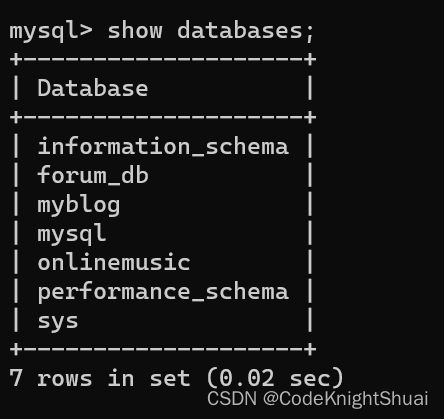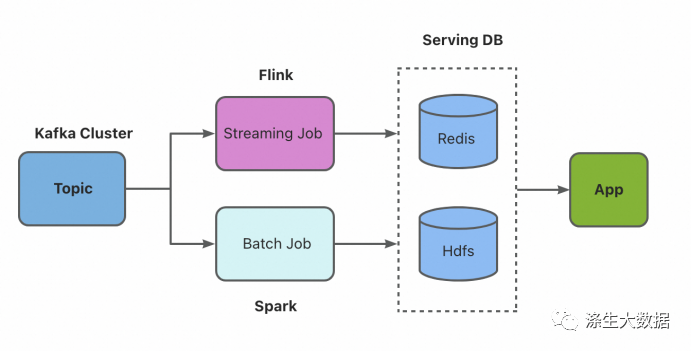Tortoise ORM
一、 简介
1、 ORM
当您构建使用关系数据库的应用程序或服务时,有时您不能仅仅使用参数化查询甚至查询构建器就可以逃脱,您只是不断重复自己,为每个实体编写略有不同的代码。代码不知道数据之间的关系,因此您最终几乎是手动连接数据。访问数据库的方式也很容易出错,从而很容易发生 SQL 注入攻击。您的数据规则也是分布式的,增加了管理数据的复杂性,更糟糕的是,应用不一致。
ORM(对象关系映射器)旨在解决这些问题,通过集中您的数据模型和数据规则,确保您的数据得到安全管理(提供对 SQL 注入的免疫力)并跟踪关系,因此您不必。
2、 介绍
Tortoise ORM 是受 Django 启发的易于使用的asyncioORM (对象关系映射器) 。
Tortoise ORM 的构建类似于 Django ORM。它的设计中不仅使用表格,还使用关系数据。
与其他 Python ORM 相比,它也表现良好,与 Pony ORM 进行交易:

官方文档地址:https://tortoise-orm.readthedocs.io/en/latest/index.html
3、 简单使用
from tortoise.models import Model
from tortoise import fields
class Tournament(Model):
id = fields.IntField(pk=True)
name = fields.TextField()
from tortoise import Tortoise, run_async
async def init():
# Here we create a SQLite DB using file "db.sqlite3"
# also specify the app name of "models"
# which contain models from "app.models"
await Tortoise.init(
db_url='sqlite://db.sqlite3',
modules={'models': ['app.models']}
)
# Generate the schema
await Tortoise.generate_schemas()
# run_async is a helper function to run simple async Tortoise scripts.
run_async(init())
数据查询:
# Create instance by save
tournament = Tournament(name='New Tournament')
await tournament.save()
# Or by .create()
await Tournament.create(name='Another Tournament')
# Now search for a record
tour = await Tournament.filter(name__contains='Another').first()
print(tour.name)
4、 环境配置
pip install tortoise-orm
# 安装数据库驱动
pip install tortoise-orm[asyncpg]
pip install tortoise-orm[aiomysql]
pip install tortoise-orm[asyncmy]
# 除此之外,还支持:aiosqlite
二、 基础配置
1、 数据库链接
语法:
支持的DB_TYPE:
更详细的可以进入官方文档查看:https://tortoise-orm.readthedocs.io/en/latest/databases.html
2、 创建数据库
from tortoise import Tortoise, run_async
async def init():
# Here we create a SQLite DB using file "db.sqlite3"
# also specify the app name of "models"
# which contain models from "app.models"
await Tortoise.init(
db_url='sqlite://db.sqlite3',
modules={'models': ['app.models']}
)
# Generate the schema
await Tortoise.generate_schemas() # safe:仅在表不存在时创建表
run_async(init()) # 会自动进入上下文处理,在运行完成时,自动关闭数据库连接
三、 模型
1、 创建
from tortoise.models import Model
class Tournament(Model):
id = fields.IntField(pk=True)
name = fields.TextField()
created = fields.DatetimeField(auto_now_add=True)
def __str__(self):
return self.name
class Event(Model):
id = fields.IntField(pk=True)
name = fields.TextField()
tournament = fields.ForeignKeyField('models.Tournament', related_name='events')
participants = fields.ManyToManyField('models.Team', related_name='events', through='event_team')
modified = fields.DatetimeField(auto_now=True)
prize = fields.DecimalField(max_digits=10, decimal_places=2, null=True)
def __str__(self):
return self.name
class Team(Model):
id = fields.IntField(pk=True)
name = fields.TextField()
class Meta:
abstract = True # 设置为True表明这是一个抽象类
table = "team" # 设置表名
table_description = "" # 设置此项可为为当前模型创建的表生成注释消息
unique_together = () # 指定unique_together为列集设置复合唯一索引,其为元组的元组(列表很好)
indexes = () # 指定indexes为列集设置复合非唯一索引,它应该是元组的元组(列表很好)
ordering = [] # 指定ordering为给定模型设置默认排序。.order_by(...)它应该可以迭代以与接收相同的方式格式化的字符串。如果查询是GROUP_BY使用默认排序的子句构建的,.annotate(...)则不应用。
manager = tortoise.manager.Manager # 指定manager覆盖默认管理器。它应该是实例tortoise.manager.Manager或子类。
2、 多表关联
from tortoise.models import Model
from tortoise import fields
class Tournament(Model):
id = fields.IntField(pk=True)
name = fields.CharField(max_length=255)
events: fields.ReverseRelation["Event"]
def __str__(self):
return self.name
class Event(Model):
id = fields.IntField(pk=True)
name = fields.CharField(max_length=255)
tournament: fields.ForeignKeyRelation[Tournament] = fields.ForeignKeyField(
"models.Tournament", related_name="events"
)
participants: fields.ManyToManyRelation["Team"] = fields.ManyToManyField(
"models.Team", related_name="events", through="event_team"
)
def __str__(self):
return self.name
class Team(Model):
id = fields.IntField(pk=True)
name = fields.CharField(max_length=255)
events: fields.ManyToManyRelation[Event]
def __str__(self):
return self.name
3、 字段
更详细的信息可以查看官方文档:https://tortoise-orm.readthedocs.io/en/latest/fields.html
3.1 数据字段
Field(source_field = None , generated = False , pk = False , null = False , default = None , unique = False , index = False , description = None , model = None , validators = None , ** kwargs
参数:
- source_field (
Optional[str]) : 如果 DB 列名称需要是特定的而不是从字段名称中生成,则提供 source_field 名称。- generated (
bool) : 该字段是否由数据库生成- pk (
bool) :该字段是否为主键- null (
bool) :主键是否可以为空- default (
Optional[Any]):该字段的默认值- unique (
bool) :该字段的值是否唯一- index (
bool):设置该字段是否为索引- description (
Optional[str]) :字段描述,也将出现在Tortoise.describe_model()生成的 DDL 中并作为 DB 注释出现。- validators (
Optional[List[Union[Validator,Callable]]]) :此字段的验证器
3.2 关系字段
ForeignKeyField( model_name , related_name = None , on_delete = 'CASCADE' , db_constraint = True , ** kwargs )
参数:
ManyToManyField(model_name, through=None, forward_key=None, backward_key='', related_name='', on_delete='CASCADE', db_constraint=True, **kwargs)
参数:
OneToOneField( model_name , related_name = None , on_delete = 'CASCADE' , db_constraint = True , ** kwargs )
4、 查询
4.1 基础
create(**kwargs):使用给定的 kwargs 创建对象get_or_create(defaults, **kwargs):获取给定 kwargs 的对象,如果未找到,则使用默认字典中的其他 kwargs 创建它
save():更新实例,或者插入它,如果它以前从未保存过delete():从数据库中删除实例fetch_related(*args):获取与实例相关的对象。它可以获取 key关系、backward-key 关系。
values() # 返回queryset里面字段的值
values_list() # 返回queryset里面字段的值,同时,内部可以指定需要返回的字段的值
events = await Event.filter(id__in=[1,2,3]).values('id', 'name', tournament_name='tournament__name') # 比如
notin:检查字段的值是否在传递列表中not_ingte:大于或等于传递的值gt:大于传递值lte:低于或等于传递的值lt:低于通过值range:介于和给定两个值之间isnull:字段为空not_isnull:字段不为空contains:字段包含指定的子字符串icontains:不区分大小写containsstartswith:如果字段以值开头istartswith:不区分大小写startswithendswith:如果字段以值结尾iendswith:不区分大小写endswithiexact:不区分大小写等于search:全文搜索
使用示例:
from tortoise.functions import Count, Trim, Lower, Upper, Coalesce
# This query will fetch all tournaments with 10 or more events, and will
# populate filed `.events_count` on instances with corresponding value
await Tournament.annotate(events_count=Count('events')).filter(events_count__gte=10)
await Tournament.annotate(clean_name=Trim('name')).filter(clean_name='tournament')
await Tournament.annotate(name_upper=Upper('name')).filter(name_upper='TOURNAMENT')
await Tournament.annotate(name_lower=Lower('name')).filter(name_lower='tournament')
await Tournament.annotate(desc_clean=Coalesce('desc', '')).filter(desc_clean='')
同时,对于一对多和多对多,可以直接使用那个字段名进行数据的操作
4.2 Q 对象
比如:
Q( * args , join_type = 'AND' , ** kwargs )
参数:
found_events = await Event.filter(
Q(Q(name='Event 1'), Q(name='Event 2'), join_type="OR") # Q(name='Event 1') | Q(name='Event 2')
)
4.3 F 表达式
F对象表示模型字段的值。它可以引用模型字段值并使用它们执行数据库操作,而无需将它们从数据库中拉出到 Python 内存中
from tortoise.expressions import F
await User.filter(id=1).update(balance = F('balance') - 10)
await User.filter(id=1).update(balance = F('balance') + F('award'), award = 0)
# or use .save()
user = await User.get(id=1)
user.balance = F('balance') - 10
await user.save(update_fields=['balance'])
五、 迁移
我们使用Aerich进行迁移 :https://github.com/tortoise/aerich
aerich -h
Usage: aerich [OPTIONS] COMMAND [ARGS]...
Options:
-c, --config TEXT Config file. [default: aerich.ini]
--app TEXT Tortoise-ORM app name. [default: models]
-n, --name TEXT Name of section in .ini file to use for aerich config.
[default: aerich]
-h, --help Show this message and exit.
Commands:
downgrade Downgrade to specified version.
heads Show current available heads in migrate location.
history List all migrate items.
init Init config file and generate root migrate location.
init-db Generate schema and generate app migrate location.
migrate Generate migrate changes file.
upgrade Upgrade to latest version.
用法:
您需要先将 aerich.models添加到您的Tortoise-ORM配置中
TORTOISE_ORM = {
"connections": {"default": "mysql://root:123456@127.0.0.1:3306/test"},
"apps": {
"models": {
"models": ["tests.models", "aerich.models"],
"default_connection": "default",
},
},
}
初始化配置文件和设置:
aerich init -t tests.backends.mysql.TORTOISE_ORM
aerich init-db # 初始化数据库
aerich migrate --name drop_column # 更新并进行迁移
aerich upgrade # 升级数据库
aerich downgrade # 降级数据库到某个版本
aerich history # 显示迁移历史
aerich heads # 显示迁移的磁头
这里大部分是理论知识,例子可以自行到官方文档查看:https://tortoise-orm.readthedocs.io/en/latest/examples/
原文地址:https://blog.csdn.net/qq_62789540/article/details/127251395
本文来自互联网用户投稿,该文观点仅代表作者本人,不代表本站立场。本站仅提供信息存储空间服务,不拥有所有权,不承担相关法律责任。
如若转载,请注明出处:http://www.7code.cn/show_32016.html
如若内容造成侵权/违法违规/事实不符,请联系代码007邮箱:suwngjj01@126.com进行投诉反馈,一经查实,立即删除!







